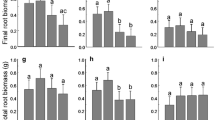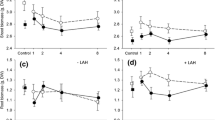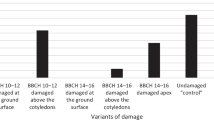Abstract
This study examined the overall impact of simulated herbivory on tillering and reproductive performance of an annual ryegrass,Lolium remotum. The interaction between herbivore damage and intraspecific competition and the effect of the timing of damage were also studied. The experimental plants were sown at two densities and were randomly assigned to eight different damage treatments consisting of artificial leaf area removal by clipping with scissors or removal of one-third of the ripening seeds. The treatments were executed at two flowering stages. The pattern of tiller development differed significantly among treatments and between densities. At the lower density, earlier treatments delayed tiller development more than the same treatments executed later. At the higher density, all treatments delayed tiller development. The density effect was significant for all reproductive traits measured. The reproductive output of plants grown at the higher density was lower and the negative treatment effects were stronger than at the lower density. The treatment effect was significant for seed dry weight per plant and individual seed weight but not for number of seeds per plant. There were no statistically significant interaction effects between the damage treatments and density, suggesting that the plants responded to the damage similarly, irrespective of the density. The plants did not totally compensate for losses due to damage at either density, even though they slightly increased their resource allocation to sexual reproduction at the higher density.
Similar content being viewed by others
References
Aggarwal PK, Fischer RA, Liboon SP (1990) Source-sink relations and effects of postanthesis canopy defoliation in wheat at low latitudes. J Agricult Sci 114: 93–99
Benner BL (1988) Effects of apex removal and nutrient supplementation on branching and seed production inThlaspi arvense (Brassicaceae). Am J Bot 75: 645–651
Carr DJ, Wardlaw IF (1965) The supply of photosynthetic assimilates to the grain from the flag leaf and ear of wheat. Aust J Biol Sci 18: 711–719
Cavers PB, Steel MG (1984) Patterns of change in seed weight over time on individual plants. Am Nat 124: 324–335
Chapin FSIII, Wardlaw IF (1988) Effect of phosphorus deficiency on source-sink interactions between the flag leaf and developing grain in barley. J Exp Bot 39: 165–177
Cook MG, Evans LT (1978) Effect of relative size and distance of competing sinks on the distribution of photosynthetic assimilates in wheat. Aust J Plant Physiol 5: 495–509
Crawley MJ, Nachapong M (1985) The establishment of seedlings from primary and regrowth seeds of ragwort (Senecio jacobaca). J Ecol 73: 255–261
Diemer MW, Pfadenhauer J (1987) Effects of differential defoliation on shoot growth, density and phytomass of three graminoids in a calcareous fen. Oikos 50: 183–190
Fenner M (1985) Seed ecology, Chapman and Hall, London
Harper JL (1981) The concept of population in modular organisms. In: May RM (ed) Theoretical ecology, Sinauer, Sunderland
Harper JL, Ogden J (1970) The reproductive strategy of higher plants. I. The concept of strategy with special reference toSenecio vulgaris L. J Ecol 58: 681–698
Hendrix SD (1979) Compensatory reproduction in a biennial herb following insect defloration. Oecologia 42: 107–118
Inouye DW (1982) The consequences of herbivory: a mixed blessing forJurinea mollis (Asteraceae). Oikos 39: 269–272
Lloyd DG, Webb CJ, Primack RB (1980) Sexual strategies in plants 2. Data on temporal regulation of maternal investment. New Phytol 86: 81–92
Lovett Doust J, Lovett Doust L (eds) (1988) Plant reproductive ecology. Patterns and strategies. Oxford University Press, New York
Louda SM, Keeler KH, Holt RD (1990) Herbivore influences on plant performance and competitive interactions. In: Grace JB, Tilman D (eds) Perspectives on plant competition. Academic, San Diego
Lubbers AE, Lechowicz MJ (1989) Effects of leaf removal on reproduction vs. belowground storage inTrillium grandiflorum. Ecology 70: 85–96
Marquis RJ (1988) Intra-crown variation in leaf herbivory and seed production in striped mapleAcer pensylvanicum L., Aceraceae. Oecologia 77: 51–55
Marquis RJ (1992) A bite is a bite is a bite? Constraints on response to folivory inPiper arieianum (Piperaceae). Ecology 73: 143–152
Marshall DL (1989) Integration of response to defoliation within plants of two species ofSesbania. Funct Ecol 3: 207–214
Marshall DL, Levin DA, Fowler NL (1985) Plasticity in yield components in response to fruit predation and date of fruit initiation in three species ofSesbania (Leguminosae). J Ecol 73: 71–81
Maschinski J, Whitham TG (1989) The continuum of plant responses to herbivory: the influence of plant association, nutrient availability and timing. Am Nat 134: 1–19
Mazer SJ (1987) Parental effects on seed development and seed yield inRaphanus raphanistrum: implications for natural and sexual selection. Evolution 41: 355–371
Mazer SJ (1989) Family mean correlations among fitness components in wild radish: controlling for maternal effects on seed weight. Can J Bot 67: 1890–1897
McNaughton SJ (1979) Grazing as an optimization process: grassungulate relationships in the Serengeti. Am Nat 113: 691–703
Meijden E ven der, Wijn M, Verkaar HJ (1988) Defence and regrowth, alternative plant strategies in the struggle against herbivores. Oikos 51: 355–363
Oesterheld M, McNaughton SJ (1988) Intraspecific variation in the response ofThemedra triandra to defoliation: the effect of time of recovery and growth rates on compensatory growth. Oecologia 77: 181–186
Oesterheld M, McNaughton SJ (1991) Effect of stress and time for recovery on the amount of compensatory growth after grazing. Oecologia 85: 305–313
SAS Institute (1985) SAS User's Guide: Statistics, Version 5 Edition. SAS Institute. Cary, North Carolina
Seppänen EJ (1970) The food-plants of the larvae of the Macrolepidoptera of Finland. (Animalia Fennica 14) WSOY, Porvoo
Sokal RR, Rohlf FJ (1981) Biometry, 2nd edn. Freeman, San Francisco
Smith RH, Bass MH (1972) Relationships of artificial pod removal to soybean yields. J Econ Entomol 65: 606–608
Thomas LP, Watson MA (1988) Leaf removal and the apparent effects of architectural constraints on development inCapsicum annuum. Am J Bot 75: 840–843
Thompson PA (1981) Variation in seed size within populations ofSilene dioica (L.) Clairv. in relation to habitat. Ann Bot 47: 623–634
Vuorisalo T, Tuomi J (1986) Unitary and modular organisms: criteria for ecological division. Oikos 47: 382–385
Watson MA (1986) Integrated physiological units in plants. Trends Ecol Evol 1: 119–123
Watson MA, Casper BB (1984) Morphogenetic constraints on patterns of carbon distribution in plants. Annu Rev Ecol Syst 15: 233–258
White J (1979) The plant as a metapopulation. Annu Rev Ecol Syst 10: 109–145
Whitham TG, Maschinski J, Larson KC, Paige KN (1991) Plant responses to herbivory: the negative to positive and underlying physiological mechanisms. In: Price PW, Lewinsohn TW, Benson WW, Fernandes GW (eds) Plant-animal interactions: evolutionary ecology in tropical and temperate regions. Wiley, New York
Woronecki PP, Stehn RA, Dolbeer RA (1980) Compensatory responses of maturing corn kernels following simulated damage by birds. J Appl Ecol 17: 737–746
Wulff RD (1986) Seed size variation inDesmodium paniculatum. II. Effects on seedling growth and physiological performance. J Ecol 74: 99–114
Author information
Authors and Affiliations
Rights and permissions
About this article
Cite this article
Mutikainen, P., Walls, M. & Ojala, A. Effects of simulated herbivory on tillering and reproduction in an annual ryegrass,Lolium remotum . Oecologia 95, 54–60 (1993). https://doi.org/10.1007/BF00649506
Received:
Accepted:
Issue Date:
DOI: https://doi.org/10.1007/BF00649506




